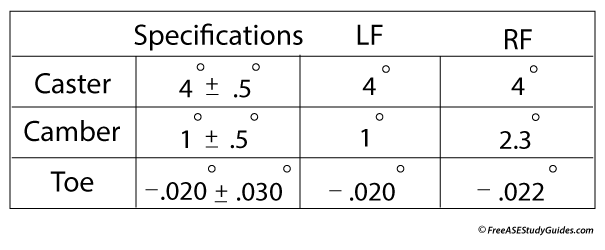ASE A4 Steering Suspension Practice Test
26. The steering wheel of a vehicle with a power rack and pinion steering system binds while turning. Which of the following is LEAST likely to cause this condition?
- A. Strut mount bearing.
- B. Worn rack bushings.
- C. Worn rack and pinion gear.
- D. Lower ball joint.
27. Technician A says an excessive, out-of-specification camber angle results in steering pull and tire wear. Technician B says a misaligned engine cradle on a front-wheel-drive vehicle affects its camber angles. Who is correct?
- A. Technician A
- B. Technician B
- C. Both A and B
- D. Neither A or B
28. The vehicle's airbag warning light illuminates after replacing the rack and pinion power steering gear. Technician A says to adjust the alignment angles to repair this light. Technician B says to check for a damaged clockspring. Who is correct?
- A. Technician A
- B. Technician B
- C. Both A and B
- D. Neither A or B
29. The left front wheel sits back 1 1/8 inches further than the right. Technician A says this is an acceptable setback designed into the vehicle to compensate for crowned roads. Technician B says a vehicle will drift towards the side with the least setback. Who is correct?
- A. Technician A
- B. Technician B
- C. Both A and B
- D. Neither A or B

30. The vehicle in the alignment chart pulls to the right. Technician A says this is because a vehicle pulls to the side with the most camber. Technician B says this is because the right front caster angle exceeds specifications. Who is correct?
- A. Technician A
- B. Technician B
- C. Both A and B
- D. Neither A or B